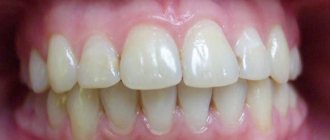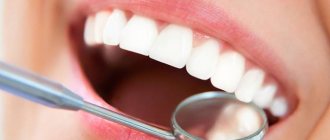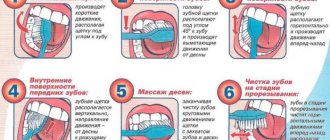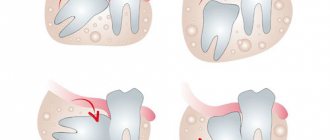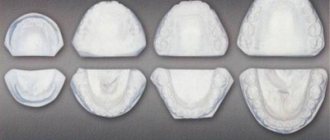Publication date: June 01, 2022.
Information on this page was updated on December 30, 2021.
Orthodontic treatment does not end with the removal of braces, because immediately after removal, the bone tissue and ligaments will begin to return to their original position and move the teeth. To consolidate the result after removing braces, it is necessary to install retention structures that will hold the teeth in the correct position until the bone tissue is finally formed around the roots of the teeth.
- What are retainers?
- Fixed retainers
- Removable retainers and mouthguards
- Combined
- How do retainers work?
- How long should retainers be worn?
- The process of installing permanent retainers
- How to care for retainers?
- Which is better: mouthguards or retainers?
- Frequently asked questions about retainers
- What problems can arise with a retainer?
- Reviews about retainers
Fixed retainers
A permanent retainer is a wire arch made of medical steel, which is attached to the inside of the teeth with a special compound. This type of retainer is used most often, as they are completely invisible, cannot be felt in the mouth and do not oxidize. Fixed retainers can come off due to mechanical stress, such as chewing hard food. In this case, you should immediately visit the orthodontist and return the retainer to its place to prevent the teeth from moving.
Fixed retainers have many advantages: you can’t forget to put them on - they are always on your teeth, and they are absolutely invisible and do not interfere. The main feature of wearing a fixed structure is the need for careful home hygiene and professional cleaning every six months at the dentist, since plaque in hard-to-reach places around the retainer is more difficult to clean.
Retainers on the jaw
A dental retainer is a removable or non-removable special device made of acrylic material or wire, fixed on the inside of the teeth, designed to prevent relapses, which may be caused by the growth of bones, alveolar processes, displacement of rows, and bad habits.
Requirements for dental retainers
:
- reliable fixation of organs in a new position;
- minimal impact on phonetics, articulation, aesthetics;
- possibility of changing the wearing mode (dosed/round-the-clock);
- minimal restriction on unit mobility;
- a dental retainer should not provoke caries or inflammatory reactions;
- the material used must have good resistance to bacterial attack.
Adaptation occurs in a short time: the device does not cause discomfort, is invisible in the oral cavity, does not spoil the appearance, and does not interfere with chewing functions.
Removable retainers and mouthguards
Removable retention structures come in two types:
- Plastic plates with a metal arch that encircles the dentition;
- Transparent mouth guards made of silicone.
After braces are removed, mouthguards or plates must be worn constantly, removed only during meals, brushing teeth, or public speaking. In the future, on the recommendation of a doctor, the time of wearing retention structures is reduced: they are removed at night and worn less during the day. Removable structures can be noticeable to others, and at first they affect diction and cause increased salivation. Typically, removable retainers are prescribed at the end of the retention period after fixed structures, but they can also be used independently throughout the entire retention period.
Plastic plates with metal arc
Silicone transparent mouth guard
Types of devices: which ones break down and come off more often
Several types of retention devices are used in orthodontic practice. Conventionally, they can be divided into removable [1] and those that cannot be removed from the mouth independently.
Removable devices
Removable types are represented by special aligners (not to be confused with aligners that straighten the dentition!). The cost of such mouthguards is low, about 3000-5000 rubles. They complete treatment in situations where it is impossible to install a permanent retainer. In some clinical cases (we will definitely consider them further), they can also act as an additional measure, and then they are used in conjunction with non-removable systems.
On a note! Rarely, removable devices such as trainers, plates and face bows are used as an auxiliary measure during the retention period. Typically, the need for their use arises when there are bite pathologies that need correction. For example, trainers are used for functional disorders and in order to form correct muscle memory.
The mouthguards are very aesthetic and easy to use. They are easy to clean and can be removed from the mouth when eating and brushing teeth. But not everyone likes the fact that the time the devices are in the mouth constantly has to be monitored. You must not forget to install mouth guards, for example, at night, and this requires a high level of self-control from patients, otherwise the entire result can quickly fade away.
You need to understand that such products simply cannot come off, since no one glues them to the teeth. The risk of their breakage is also low.
Fixed structures
In most cases, treatment results are consolidated using the second group of devices, which are non-removable. These are the ones that are fixed to the teeth using special glue and filling material.
The structures consist of stainless metal wire or other rigid material (fiberglass and nylon thread). They are fixed in pre-created grooves or recesses on the inner (lingual) side of the row. Or they are simply glued to the inner surface of the teeth (today this option is used more often).
Non-removable retainers are lightweight, compact, aesthetic, do not cause discomfort and do not interfere with the beauty of your smile, and are designed for a long period of use. That is why they are installed on a large number of patients. True, you have to get used to it, because... in the first few days the structure will interfere with the tongue.
Important! A non-removable retainer accompanies the patient while eating, brushing teeth, talking, sleeping; hygienic care of the oral cavity is difficult in it, so situations often occur when it comes off, falls off or bends.
How do retainers work?
Braces or aligners actively move teeth in the desired direction due to the traction of the arch and pressure on the dentition. A non-removable wire retainer does not put pressure on the teeth, but only holds them in the desired position, preventing them from moving apart. Removable aligners differ from aligners in that they are not used with attachments (activators of tooth movement), but exactly repeat the shape of the dentition and fit tightly to the teeth, fixing the dentition. Any retention structure does not move the teeth, but at the same time it should prevent the ligaments from relaxing and returning to their previous position until the bone tissue around is completely strengthened.
Terms of wearing
Regarding the timing of wearing retainers, approximate information is given by the doctor who monitors the treatment process. There is an average formula for calculating the duration of the retention period, according to which the period of wearing the braces system must be multiplied by two.
While the results are being consolidated, two types of retainers can be used: fixed and removable. Immediately after removing braces, permanent braces are usually prescribed, which do not put pressure on the teeth, but simply fix them in the desired position. Fixed systems are secured to the inner surfaces of teeth using filling material. Removable ones are prescribed later, when the impact may no longer be permanent, but temporary – for several hours a day.
Removable retainers can be in the form of a mouth guard or a plate, while a non-removable retainer is attached to the back of the teeth
During the period of wearing fixed structures, the orthodontic device may come off or break, which negatively affects the treatment process.
How long should retainers be worn?
The duration of the retention period is on average 2 times longer than wearing braces, and patients who corrected their bite in adulthood - after 25-30 years, can wear retainers all their lives.
The length of time you wear retainers usually varies from person to person and depends on the following factors:
- Age of the orthodontic patient. The younger a person is, the faster his ligaments and muscles are rebuilt, thereby fixing the teeth and bite in the correct position. For patients who received braces as teenagers, wearing retainers for 6 months to 2 years is sometimes sufficient.
- Bad habits. People who smoke have poor blood supply and reduced immunity, so all processes of restructuring the position of teeth and healing are slower than in non-smokers.
- Oral health. If the teeth and periodontal tissues are healthy, the fixation of the ligamentous apparatus occurs faster.
- Complexity of the clinical case. The stronger the initial curvature of the teeth, the longer you need to wear a retainer.
The retention period must be carried out under the supervision of an orthodontist so that he monitors the condition of the bite. In any case, you should not stop wearing retainers without your doctor's approval, otherwise your teeth may become crooked again.
Wearing time
The optimal option is to fix the retainer on six frontal units, the simplified option is to fix it on four incisors, but in this case there is a risk of the canines returning to their original location.
To prevent the opening of the gap in the tooth extraction area, premolars are connected to the device:
- Retainers on the upper jaw should last 5-10 years. If, during correction, good closure in the lateral/anterior sections is achieved, treatment continued for 1.5-2 years, the retention period is reduced to 2-3 years;
- Duration of wearing on the lower one is at least 10-15 years. This is due to the instability of the incisors and their predisposition to relapse. .
The process of installing permanent retainers
Retainers are installed after braces are removed on completely healthy teeth after professional hygiene. The patient may need to undergo oral sanitation after orthodontic treatment. While wearing braces, it is difficult to clean your teeth perfectly, and accumulated plaque can cause caries and tartar. Retainers cannot be installed on affected teeth, since another design in the mouth will again complicate hygiene and lead to a deterioration in the condition of the oral cavity. Also, during orthodontic treatment, the enamel may become thinner, so in addition to hygienic cleaning, teeth need fluoridation and mineralization.
After carrying out therapeutic and preventive measures, the orthodontist begins the laboratory stage of manufacturing retainers. An impression is taken from healthy teeth, according to which the retainer is given the necessary shape of the dentition.
Before the actual installation of the retainer, the teeth are etched with a special solution so that their surface becomes slightly rougher for better adhesion. In some cases, instead of etching the teeth, the teeth are prepared: a microgroove is drilled on the inside to fix the retainer. Once the teeth are prepared, the retainer is placed in the desired position and secured with composite material. The procedure is completed by grinding the material for the patient’s convenience.
The installation procedure takes 15-20 minutes and is absolutely painless. But in the first days of adaptation, the retainer can rub and reduce the clarity of diction.
Prices for installing retainers
To calculate the cost of permanent dental retainers, sign up for a consultation at Dr. Razumenko’s dentistry in Moscow. To do this, fill out an application on the website or call.
| Code no. | Name of procedures | Unit of measurement | Cost, rub. |
| 901 | Initial oral consultation with a dentist - orthodontist | 2 500,00 | |
| 914 | Gluing a retainer (bracket) | 1 tooth | 850,00 |
| 964 | Joint splint Splint | 27 000,00 | |
| 965 | Retention tray transparent | 1 person | 6 000,00 |
| 966 | Mouthguard for the treatment of bruxism | 15 000,00 | |
| 967 | Sports mouthguard 5 layers | 20 000,00 | |
| 968 | Sports mouthguard for children | 10 000,00 | |
| 969 | Mouthguard 3X layer | 15 000,00 | |
| 976 | Small course (up to 14 aligners) made in the Invisalign laboratory | 220 000,00 | |
| 977 | Full course (from 14 aligners) made in the Invisalign laboratory | 280 000,00 |
* The prices indicated on the website are not a public offer. The exact cost of treatment can only be determined at an appointment with a doctor.
Prices for treatment in Moscow full price list
Share on social media networks:
Article Expert:
Oganesyan Diana Feliksovna
Dentist-orthodontist. He regularly improves his professional level and studies modern methods of orthodontic treatment at international seminars and conferences of outstanding orthodontists in the world. He is a member of the Italian Society of Orthodontists (SIDO) and the European Aligner Association (EAS).
Work experience over 6 years
How to care for retainers?
Retainers, like any structure in the mouth, without careful hygiene provoke the accumulation of bacteria, the appearance of plaque and caries.
- You can brush your teeth with a regular toothbrush and toothpaste, but be careful when brushing the inside of your teeth if you have a permanent retainer;
- If the retainer comes unstuck, you need to visit the orthodontist and return it to its place so that an orthodontic relapse does not occur;
- For thorough hygiene when wearing fixed retainers, it is recommended to use a waterpik, brushes and dental floss to clean hard-to-reach places near the arch;
- Removable retainers and mouth guards should be washed with disinfectants, soap, or brushed with toothpaste at least 2 times a day.
- Mouthguards must be removed when eating and smoking and stored in special containers;
- Mouthguards should not be washed with hot water because they will become deformed.
- To strengthen the enamel, it is recommended to rinse the mouth with a fluoride solution.
After braces are removed and retainers are installed, you should periodically visit the orthodontist for follow-up examinations and the hygienist to maintain oral health. Only after the end of the retention period can orthodontic treatment be considered complete.
Stages of use
Depending on the type of structure, it needs to be used differently.
The non-removable model is left untouched and cleaned by the dentist once a year. Removable aligners are removed during meals. It is recommended to wear them at night and soak them in a special solution when not in use. Retention plates require the same care, with the difference that they are worn at night.
Retention plates
In the first 2-3 months, the retainer is in the mouth around the clock and is removed only during meals. After that, they are used only at night. After a year - once every 2-3 nights. But these are average periods; they must be worn according to the doctor’s recommendations.
Which is better: mouthguards or retainers?
Retention mouthguards and a non-removable retainer after orthodontic treatment are used in combination: a non-removable retainer from canine to fang is permanently placed on the teeth, the mouthguard is put on at night. After removing braces, we give patients 2 mouthguards: a night guard for all teeth in the upper dentition and a canine-to-canine safety mouthguard for the lower dentition, which is needed if the retainer breaks and there is no way to quickly make an appointment with an orthodontist. From the point of view of patient comfort, a non-removable retainer is more convenient than a mouth guard, since a week after installation, it is practically not felt in the mouth. And the mouth guards are quite bulky and it’s more difficult to get used to them.
Retention devices and structures
In each individual case, the doctor will recommend a specific type of construction. One of the most popular and used is considered a non-removable retainer after braces. A retainer is a metal structure in the form of a wire or arc, which is attached to the inside of the teeth with filling material. The retainer is made of a special material that securely holds the teeth and at the same time allows you to follow the shape of the dentition for an optimal fit. Almost always, retainers are installed on the 6 front teeth (from canine to canine) and 2 more teeth for better stabilization. Retention plates also help stabilize the result. Their features include: the ability to better maintain the width of the dentition, especially if the narrow upper jaw was expanded during active treatment; the possibility of micro-movements of the teeth in the upper jaw. Thus, the body can better adapt, forming an optimal closure of the teeth;
with the help of two-jaw devices, the bite is controlled; the design of the plates is more reliable than retainers. It can be successfully used by people suffering from bruxism (unconscious squeezing of teeth to the point of grinding); it is comfortable to wear, but is inferior to retainers due to the presence of a plastic base that covers the palate; it is more difficult to manufacture, so it costs a little more. Retainers and plates are effective designs to consolidate the results. The orthodontist prescribes a specific type, taking into account the clinical situation or individual wishes, if both options are acceptable. The most important thing is to comply with the wearing conditions, and you will be able to maintain the perfect smile obtained during treatment.
Frequently asked questions about retainers:
Typically, patients who are thinking about installing braces learn about the need to wear a retainer during a consultation with an orthodontist. We have collected the most common questions that patients ask about the retention period.
How long to wear a retainer?
The minimum period for an adult patient is twice as long as the period of orthodontic treatment. Our recommended period is from 5 to 10 years, depending on the complexity of the case and the type of retention. Many patients do not feel the retainer on their teeth and quietly wear it all their lives.
Is it possible to do an MRI with a retainer?
Yes, an MRI can be done with a retainer, just like with braces, but due to the presence of metal in the mouth, there may be interference in the final image.
Do I need to change my permanent retainer?
If the retainer is not broken or unstuck, then there is no need to change it. To maintain good hygiene in the retainer area, use a single-tuft brush, brushes, dental floss, and regular professional hygiene.
Is there a warranty for the retainer?
In our clinic, the warranty on the retainer lasts 2 years. If during this time the retainer breaks or comes off, we will replace it absolutely free of charge.
Can teeth move apart if a retainer is installed?
If orthodontic treatment is completed correctly - the correct closure and position of the teeth is achieved, then with a permanent retainer, the teeth will remain in the correct position. If the retainer comes unstuck or breaks, you need to install it as quickly as possible, since even in a month your teeth can change position.
How can you tell if your retainer has come off?
This is not difficult to do. The design may begin to cause discomfort, scratch the oral mucosa, and leave wounds on the tongue or palate. Patients who suffer from pathology often notice a strange crunching sound while eating food.
If you do not solve the problem, you will notice that in the place where the retainer broke, the tooth “moved away”, that is, it shifted to its original position, which it occupied at the previous stages of treatment. Doctors say that this phenomenon is more typical for the lower jaw, the incisors and canines of which can change their positions in just a few days. You can see in the photo what the oral cavity looks like when the retainer has come off and the teeth have begun to move back apart.
“I didn’t immediately notice that my retainer had come off. The wire is so thin that I didn’t even feel any discomfort. And I found out about the problem in a very interesting way: during one of my morning brushings I saw in the mirror that a gap had appeared between my teeth, which, oh my God, took me a year and a half to get rid of!!! True, the diastema was smaller than before, but still! This is very disappointing! Be more attentive to yourself and don’t think that because you wear retainers, you don’t need to control this process the same way as with braces. It’s necessary, and how!”
Tinka, review from gidpozubam.ru
What problems can arise with a retainer?
The first thing a person who has a permanent retainer installed will face is getting used to it. At first, the retainer may rub your tongue, feel too big in your mouth, and interfere with clear diction. The retainer becomes invisible in the mouth after about a week.
The next task for a patient with a retainer is careful home hygiene, since food debris can get stuck in the spaces between the teeth and the retainer. For home cleaning, we recommend using a single-tuft brush, brushes, dental floss and irrigator.
The retainer may break or come off due to hard foods. In this case, you need to contact your doctor for a replacement.
If caries appears in the area of the retainers on the teeth, then for treatment by a therapist, the retainer will need to be removed and then reinstalled.
What absolutely should not be done if a problem arises
- remain inactive for a long time: if the retainer comes off, how long can you walk like this? Doctors say that the maximum that is possible here is 2-4 days. If you ignore the problem for longer, the teeth will gradually begin to take the incorrect position that they occupied before the bite correction,
- glue the device yourself, especially using non-medical adhesives: you can cause damage to surrounding tissues, provoke an inflammatory process,
- tear off or cut off the loose piece,
- remove the device at home: you can damage your teeth, gums, and mucous membranes.
How to install and remove a retainer
You can remove and put on the plate or mouth guard yourself; the dentist will only comment once and show it.
Stages of installing permanent retainers:
- preparation of the oral cavity (removal of plaque, treatment of caries, mineralization of enamel);
- taking an impression of the jaw and making a retention apparatus in accordance with it;
- fixation of the finished busbar-wire with composite materials.
The retainer can only be removed at the dentist's office. It is usually cut down with a bur. It is painless and harmless. After the procedure, refrain from hot or too cold foods, sour and hard foods (nuts, crackers, etc.).
